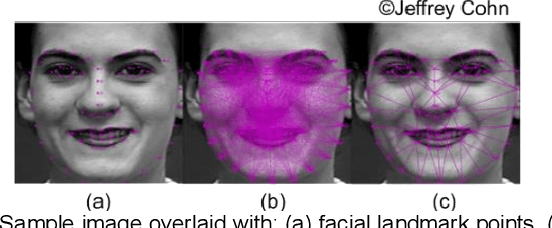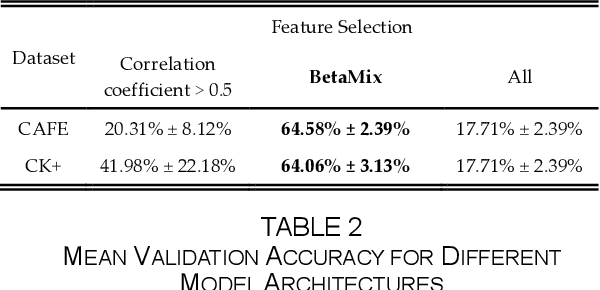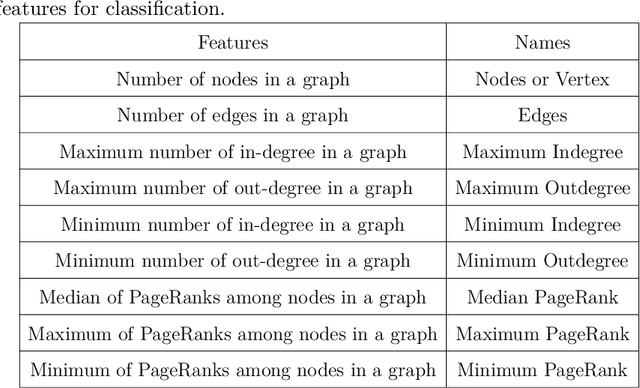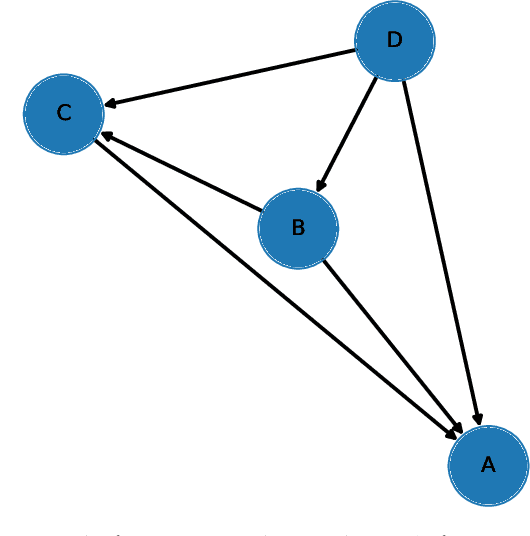Manar D. Samad
No Imputation of Missing Values In Tabular Data Classification Using Incremental Learning
Apr 20, 2025Abstract:Tabular data sets with varying missing values are prepared for machine learning using an arbitrary imputation strategy. Synthetic values generated by imputation models often concern data stakeholders about computational complexity, data quality, and data-driven outcomes. This paper eliminates these concerns by proposing no imputation incremental learning (NIIL) of tabular data with varying missing value rates and types. The proposed method incrementally learns partitions of overlapping feature sets while using attention masks to exclude missing values from attention scoring. The average classification performance rank order across 15 diverse tabular data sets highlights the superiority of NIIL over 11 state-of-the-art learning methods with or without missing value imputations. Further experiments substantiate the robustness of NIIL against varying missing value types and rates compared to methods that involve the imputation of missing values. Our empirical analysis reveals that a feature partition size of half of the original feature space is, computation-wise and accuracy-wise, the best choice for the proposed incremental learning. The proposed method is one of the first deep learning solutions that can effectively learn tabular data without requiring the imputation of missing values.
DeepIFSA: Deep Imputation of Missing Values Using Feature and Sample Attention
Jan 19, 2025Abstract:Missing values of varying patterns and rates in real-world tabular data pose a significant challenge in developing reliable data-driven models. Existing missing value imputation methods use statistical and traditional machine learning, which are ineffective when the missing rate is high and not at random. This paper explores row and column attention in tabular data to address the shortcomings of existing methods by introducing a new method for imputing missing values. The method combines between-feature and between-sample attention learning in a deep data reconstruction framework. The proposed data reconstruction uses CutMix data augmentation within a contrastive learning framework to improve the uncertainty of missing value estimation. The performance and generalizability of trained imputation models are evaluated on set-aside test data folds with missing values. The proposed joint attention learning outperforms nine state-of-the-art imputation methods across several missing value types and rates (10%-50%) on twelve data sets. Real electronic health records data with missing values yield the best classification accuracy when imputed using the proposed attention learning compared to other statistical, machine learning, and deep imputation methods. This paper highlights the heterogeneity of tabular data sets to recommend imputation methods based on missing value types and data characteristics.
Transfer Learning of Tabular Data by Finetuning Large Language Models
Jan 12, 2025Abstract:Despite the artificial intelligence (AI) revolution, deep learning has yet to achieve much success with tabular data due to heterogeneous feature space and limited sample sizes without viable transfer learning. The new era of generative AI, powered by large language models (LLM), brings unprecedented learning opportunities to diverse data and domains. This paper investigates the effectiveness of an LLM application programming interface (API) and transfer learning of LLM in tabular data classification. LLM APIs respond to input text prompts with tokenized data and instructions, whereas transfer learning finetunes an LLM for a target classification task. This paper proposes an end-to-end finetuning of LLM to demonstrate cross-data transfer learning on ten benchmark data sets when large pre-trained tabular data models do not exist to facilitate transfer learning. The proposed LLM finetuning method outperforms state-of-the-art machine and deep learning methods on tabular data with less than ten features - a standard feature size for tabular data sets. The transfer learning approach uses a fraction of the computational cost of other deep learning or API-based solutions while ensuring competitive or superior classification performance.
Attention versus Contrastive Learning of Tabular Data -- A Data-centric Benchmarking
Jan 08, 2024Abstract:Despite groundbreaking success in image and text learning, deep learning has not achieved significant improvements against traditional machine learning (ML) when it comes to tabular data. This performance gap underscores the need for data-centric treatment and benchmarking of learning algorithms. Recently, attention and contrastive learning breakthroughs have shifted computer vision and natural language processing paradigms. However, the effectiveness of these advanced deep models on tabular data is sparsely studied using a few data sets with very large sample sizes, reporting mixed findings after benchmarking against a limited number of baselines. We argue that the heterogeneity of tabular data sets and selective baselines in the literature can bias the benchmarking outcomes. This article extensively evaluates state-of-the-art attention and contrastive learning methods on a wide selection of 28 tabular data sets (14 easy and 14 hard-to-classify) against traditional deep and machine learning. Our data-centric benchmarking demonstrates when traditional ML is preferred over deep learning and vice versa because no best learning method exists for all tabular data sets. Combining between-sample and between-feature attentions conquers the invincible traditional ML on tabular data sets by a significant margin but fails on high dimensional data, where contrastive learning takes a robust lead. While a hybrid attention-contrastive learning strategy mostly wins on hard-to-classify data sets, traditional methods are frequently superior on easy-to-classify data sets with presumably simpler decision boundaries. To the best of our knowledge, this is the first benchmarking paper with statistical analyses of attention and contrastive learning performances on a diverse selection of tabular data sets against traditional deep and machine learning baselines to facilitate further advances in this field.
Between-Sample Relationship in Learning Tabular Data Using Graph and Attention Networks
Jun 11, 2023Abstract:Traditional machine learning assumes samples in tabular data to be independent and identically distributed (i.i.d). This assumption may miss useful information within and between sample relationships in representation learning. This paper relaxes the i.i.d assumption to learn tabular data representations by incorporating between-sample relationships for the first time using graph neural networks (GNN). We investigate our hypothesis using several GNNs and state-of-the-art (SOTA) deep attention models to learn the between-sample relationship on ten tabular data sets by comparing them to traditional machine learning methods. GNN methods show the best performance on tabular data with large feature-to-sample ratios. Our results reveal that attention-based GNN methods outperform traditional machine learning on five data sets and SOTA deep tabular learning methods on three data sets. Between-sample learning via GNN and deep attention methods yield the best classification accuracy on seven of the ten data sets. This suggests that the i.i.d assumption may not always hold for most tabular data sets.
Deep Imputation of Missing Values in Time Series Health Data: A Review with Benchmarking
Feb 10, 2023Abstract:The imputation of missing values in multivariate time series data has been explored using a few recently proposed deep learning methods. The evaluation of these state-of-the-art methods is limited to one or two data sets, low missing rates, and completely random missing value types. These limited experiments do not comprehensively evaluate imputation methods on realistic data scenarios with varying missing rates and not-at-random missing types. This survey takes a data-centric approach to benchmark state-of-the-art deep imputation methods across five time series health data sets and six experimental conditions. Our extensive analysis reveals that no single imputation method outperforms the others on all five data sets. The imputation performance depends on data types, individual variable statistics, missing value rates, and types. In this context, state-of-the-art methods jointly perform cross-sectional (across variables) and longitudinal (across time) imputations of missing values in time series data. However, variables with high cross-correlation can be better imputed by cross-sectional imputation methods alone. In contrast, the ones with time series sensor signals may be better imputed by longitudinal imputation methods alone. The findings of this study emphasize the importance of considering data specifics when choosing a missing value imputation method for multivariate time series data.
G-CEALS: Gaussian Cluster Embedding in Autoencoder Latent Space for Tabular Data Representation
Jan 05, 2023Abstract:The latent space of autoencoders has been improved for clustering image data by jointly learning a t-distributed embedding with a clustering algorithm inspired by the neighborhood embedding concept proposed for data visualization. However, multivariate tabular data pose different challenges in representation learning than image data, where traditional machine learning is often superior to deep tabular data learning. In this paper, we address the challenges of learning tabular data in contrast to image data and present a novel Gaussian Cluster Embedding in Autoencoder Latent Space (G-CEALS) algorithm by replacing t-distributions with multivariate Gaussian clusters. Unlike current methods, the proposed approach independently defines the Gaussian embedding and the target cluster distribution to accommodate any clustering algorithm in representation learning. A trained G-CEALS model extracts a quality embedding for unseen test data. Based on the embedding clustering accuracy, the average rank of the proposed G-CEALS method is 1.4 (0.7), which is superior to all eight baseline clustering and cluster embedding methods on seven tabular data sets. This paper shows one of the first algorithms to jointly learn embedding and clustering to improve multivariate tabular data representation in downstream clustering.
Are Deep Image Embedding Clustering Methods Effective for Heterogeneous Tabular Data?
Dec 28, 2022Abstract:Deep learning methods in the literature are invariably benchmarked on image data sets and then assumed to work on all data problems. Unfortunately, architectures designed for image learning are often not ready or optimal for non-image data without considering data-specific learning requirements. In this paper, we take a data-centric view to argue that deep image embedding clustering methods are not equally effective on heterogeneous tabular data sets. This paper performs one of the first studies on deep embedding clustering of seven tabular data sets using six state-of-the-art baseline methods proposed for image data sets. Our results reveal that the traditional clustering of tabular data ranks second out of eight methods and is superior to most deep embedding clustering baselines. Our observation is in line with the recent literature that traditional machine learning of tabular data is still a competitive approach against deep learning. Although surprising to many deep learning researchers, traditional clustering methods can be competitive baselines for tabular data, and outperforming these baselines remains a challenge for deep embedding clustering. Therefore, deep learning methods for image learning may not be fair or suitable baselines for tabular data without considering data-specific contrasts and learning requirements.
Deep Adaptation of Adult-Child Facial Expressions by Fusing Landmark Features
Sep 18, 2022



Abstract:Imaging of facial affects may be used to measure psychophysiological attributes of children through their adulthood, especially for monitoring lifelong conditions like Autism Spectrum Disorder. Deep convolutional neural networks have shown promising results in classifying facial expressions of adults. However, classifier models trained with adult benchmark data are unsuitable for learning child expressions due to discrepancies in psychophysical development. Similarly, models trained with child data perform poorly in adult expression classification. We propose domain adaptation to concurrently align distributions of adult and child expressions in a shared latent space to ensure robust classification of either domain. Furthermore, age variations in facial images are studied in age-invariant face recognition yet remain unleveraged in adult-child expression classification. We take inspiration from multiple fields and propose deep adaptive FACial Expressions fusing BEtaMix SElected Landmark Features (FACE-BE-SELF) for adult-child facial expression classification. For the first time in the literature, a mixture of Beta distributions is used to decompose and select facial features based on correlations with expression, domain, and identity factors. We evaluate FACE-BE-SELF on two pairs of adult-child data sets. Our proposed FACE-BE-SELF approach outperforms adult-child transfer learning and other baseline domain adaptation methods in aligning latent representations of adult and child expressions.
GGNB: Graph-Based Gaussian Naive Bayes Intrusion Detection System for CAN Bus
Aug 24, 2021



Abstract:The national highway traffic safety administration (NHTSA) identified cybersecurity of the automobile systems are more critical than the security of other information systems. Researchers already demonstrated remote attacks on critical vehicular electronic control units (ECUs) using controller area network (CAN). Besides, existing intrusion detection systems (IDSs) often propose to tackle a specific type of attack, which may leave a system vulnerable to numerous other types of attacks. A generalizable IDS that can identify a wide range of attacks within the shortest possible time has more practical value than attack-specific IDSs, which is not a trivial task to accomplish. In this paper we propose a novel {\textbf g}raph-based {\textbf G}aussian {\textbf n}aive {\textbf B}ayes (GGNB) intrusion detection algorithm by leveraging graph properties and PageRank-related features. The GGNB on the real rawCAN data set~\cite{Lee:2017} yields 99.61\%, 99.83\%, 96.79\%, and 96.20\% detection accuracy for denial of service (DoS), fuzzy, spoofing, replay, mixed attacks, respectively. Also, using OpelAstra data set~\cite{Guillaume:2019}, the proposed methodology has 100\%, 99.85\%, 99.92\%, 100\%, 99.92\%, 97.75\% and 99.57\% detection accuracy considering DoS, diagnostic, fuzzing CAN ID, fuzzing payload, replay, suspension, and mixed attacks, respectively. The GGNB-based methodology requires about $239\times$ and $135\times$ lower training and tests times, respectively, compared to the SVM classifier used in the same application. Using Xilinx Zybo Z7 field-programmable gate array (FPGA) board, the proposed GGNB requires $5.7 \times$, $5.9 \times$, $5.1 \times$, and $3.6 \times$ fewer slices, LUTs, flip-flops, and DSP units, respectively, than conventional NN architecture.
 Add to Chrome
Add to Chrome Add to Firefox
Add to Firefox Add to Edge
Add to Edge